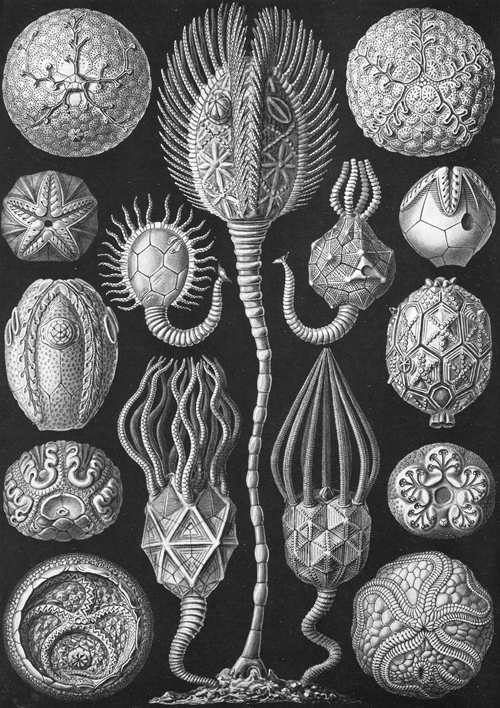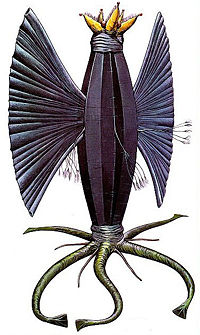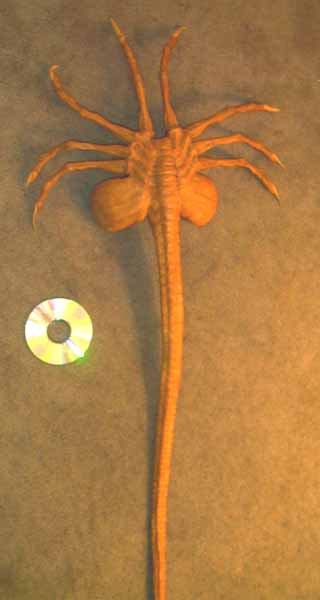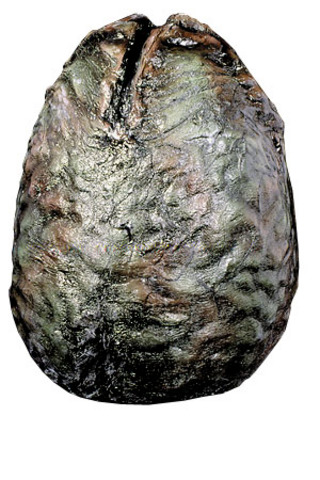[2008-07-08] The influence of Haeckels plate 90 on Lovecraft and Giger

The place of Earnst Haeckel's beautiful lithographs Kunstformen der Natur ("Art Forms in Nature") in the history of science and art is well-documented. More particularly, the influence of Haeckel's illustrations on foundational American horror writer H.P. Lovecraft has also been thoroughly established. However, while perusing the 1976 Dover edition of Haeckel's prints recently, I was struck by the particular significance of Haeckel's plate number 90, which is reproduced at the top of this page. The English caption accompanying the plate in my edition reads, "Various species of Cystoidea, extinct allies of the starfish."
That caption is important to my argument that plate 90, in particular, has had extremely broad-reaching influence on the imagination of alien and other-worldly life in the twentieth century. The most important connection, of course, is through Lovecraft, in particular the so-called "Elder Things" from his definitive novella At the Mountains of Madness. His famous description of their physiology is exceprted below:
Objects are eight feet long all over. Six-foot, five-ridged barrel torso three and five-tenths feet central diameter, one foot end diameters. Dark gray, flexible, and infinitely tough. Seven-foot membranous wings of same color, found folded, spread out of furrows between ridges. Wing framework tubular or glandular, of lighter gray, with orifices at wing tips. Spread wings have serrated edge. Around equator, one at central apex of each of the five vertical, stave-like ridges are five systems of light gray flexible arms or tentacles found tightly folded to torso but expansible to maximum length of over three feet. Like arms of primitive crinoid. Single stalks three inches diameter branch after six inches into five substalks, each of which branches after eight inches into small, tapering tentacles or tendrils, giving each stalk a total of twenty-five tentacles.
At top of torso blunt, bulbous neck of lighter gray, with gill-like suggestions, holds yellowish five-pointed starfish-shaped apparent head covered with three-inch wiry cilia of various prismatic colors.
Head thick and puffy, about two feet point to point, with three-inch flexible yellowish tubes projecting from each point. Slit in exact center of top probably breathing aperture. At end of each tube is spherical expansion where yellowish membrane rolls back on handling to reveal glassy, red-irised globe, evidently an eye.
Five slightly longer reddish tubes start from inner angles of starfish-shaped head and end in saclike swellings of same color which, upon pressure, open to bell-shaped orifices two inches maximum diameter and lined with sharp, white tooth like projections - probably mouths. All these tubes, cilia, and points of starfish head, found folded tightly down; tubes and points clinging to bulbous neck and torso. Flexibility surprising despite vast toughness.
At bottom of torso, rough but dissimilarly functioning counterparts of head arrangements exist. Bulbous light-gray pseudo-neck, without gill suggestions, holds greenish five-pointed starfish arrangement.
Tough, muscular arms four feet long and tapering from seven inches diameter at base to about two and five-tenths at point. To each point is attached small end of a greenish five-veined membranous triangle eight inches long and six wide at farther end. This is the paddle, fin, or pseudofoot which has made prints in rocks from a thousand million to fifty or sixty million years old.
From inner angles of starfish arrangement project two-foot reddish tubes tapering from three inches diameter at base to one at tip. Orifices at tips. All these parts infinitely tough and leathery, but extremely flexible. Four-foot arms with paddles undoubtedly used for locomotion of some sort, marine or otherwise. When moved, display suggestions of exaggerated muscularity. As found, all these projections tightly folded over pseudoneck and end of torso, corresponding to projections at other end.
And here is artist Wayne Barlowe's conception of an Elder Thing (from his excellent Barlowe's Guide to Extraterrestrials) based in the above description:

Apart from the embellishment of wings and "crinoid arms" (another clear verbal link to Haeckel), the visual resemblance between Barlowe's conception of an Elder Thing and cystoidea from Haeckel's plate 90 (particularly specimens in lower center of plate, to either side of central tail) is strong. Besides the central barrel-shaped body terminating in one or more groups of tentacles, there is the five-fold radial symmetry combined with Lovecraft's repeated use of the word "starfish" as descriptive simile. Moreover, the particular details of the caption--that the Cystoidea are "extinct" and "allies"--also seem evocative in the context of Lovecraft's Elder Things. "Extinct," after all, is nearly synonymous with "elder," and the use of the particular word "allies" to suggest organisms with an organized society capable of waging war harkens to Lovecraft's theosophic accounts, from the same text, of brutal wars waged between the Elder Things other alien races in the Earth's immemorable pre-history. Indeed, to describe the Elder Things themselves as "extinct allies of the starfishes" is not an unfair summation.
The second important connection between plate 90 and modern monster imagery is through H.R. Giger, whose "biomechanical" aesthetic was made famous in the design of the creature from the 1979 movie Alien and its sequels. Again, the general connection between Haeckel and Giger is well-documented, but I would emphasize the importance of plate 90 in particular. Here, the visual connections are stronger even than in Lovecraft. Especially noticable is the similarity between the five central specimens of the plate and the "facehugger" stage of Giger's organism's life-cycle. A prop replica is shown below:

Radial has been reduced to bilateral symmetry, but the basic configuration of the organisms is identical: A central body with a bundle of appendages at one end and a single muscular tail/appendage at the other. It is easy to imagine a young Giger staring at Haeckel's plate 90 and envisioning a human head entrapped in those tentacles. Note also the strong resemblence between the spheroid specimens around the periphery of plate 90 and the "egg" stage of Giger's organism. The association of these two strongly evocative images--the organism and the egg from which it emerges--on the same plate is surely not coincidental.

last modified 2008-07-08